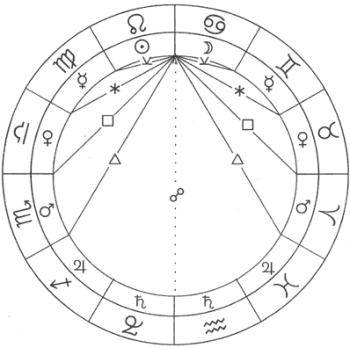 In the scheme of planetary rulership outlined by Ptolemy, we see a symmetry that can be otherwise obscured in modern astrology with the addition of Uranus, Neptune, and Pluto as sign rulers. Uranus is the modern ruler of Aquarius, Neptune of Pisces, and Pluto of Scorpio. Traditionally, these signs are ruled by Saturn, Jupiter, and Mars respectively, and we refer to the diagram to see why.
In the scheme of planetary rulership outlined by Ptolemy, we see a symmetry that can be otherwise obscured in modern astrology with the addition of Uranus, Neptune, and Pluto as sign rulers. Uranus is the modern ruler of Aquarius, Neptune of Pisces, and Pluto of Scorpio. Traditionally, these signs are ruled by Saturn, Jupiter, and Mars respectively, and we refer to the diagram to see why.
The Sun and Moon, the main luminaries in the chart and sky, represent the base concepts of masculine (Sun) and feminine (Moon) in astrology. This is why they only rule one sign each, contrasted with the dual rulership every other planet enjoys in the traditional scheme. Mercury through Saturn each rule one masculine (‘day’) sign and one feminine (‘night’) sign. The Moon rules only her feminine (water) sign of Cancer, the Sun only his masculine (fire) sign of Leo – the Moon will never be ‘at home’ in a masculine sign, as it goes against her nature; the converse is true for the Sun.
On either side of the houses of the luminaries are the houses ruled by Mercury, our hermaphroditic messenger: he rules the signs of Gemini (day / masculine) and Virgo (night / feminine). As Mercury is the closest planet to the Sun, never separated more than 28 degrees, it is a suitable ruler for those signs which form semi-sextiles (30°) to the luminaries. This further illustrates Mercury’s proclivity for communication and travel – its main function is to take care of business in proximity to the Sun and bridge the gap to the slower planets.
Forming a sextile (60°) aspect to the luminaries are the signs ruled by Venus: Libra by day, Taurus by night. As Venus is a feminine body, she prefers her placement in feminine Taurus to masculine Libra, but exercises dominion over planets placed in either of these signs all the same. The sextile is a harmonious aspect and demonstrates why Venus is the ‘lesser benefic’. Any two planets in sextile will be in signs that agree in gender, an important basis for relationship.
The lesser malefic, Mars, rules the signs that form a square (90°) to the houses of the luminaries: Aries by day, Scorpio by night. As an emphatically masculine planet, Mars’ preferred placement in its day sign of Aries is clear. Mars’ rulership of Scorpio is less intuitively apparent, perhaps one reason why Pluto has taken over in modern schemes and general consciousness. The hottest planet in a watery, feminine sign does suggest an emphasis on the need for base adaptation and transformation, which fits well with Pluto’s symbolism and effects.
Similarly, the ‘greater benefic’, Jupiter, also rules one fire and one water sign: Sagittarius by day, Pisces by night. Another masculine planet, Jupiter prefers his placement in Sagittarius, and in modern rulership this means that Pisces has come to be more identified with Neptune, a suitably oceanic and receptive body. The signs ruled by Jupiter form a trine (120°) to the luminaries, further cementing its reputation as the ‘lucky’ planet.
Finally, the signs in opposition – the ‘farthest’ aspect, 180° – to the luminaries are ruled by the ‘greater malefic’ Saturn: Aquarius by day, Capricorn by night. Saturn defines boundaries and limits and is unyielding, important keywords in examining the opposition aspect. It is interesting that Saturn’s modern rulership seems to have departed the farthest from traditional – as a masculine body, he prefers his day sign of Aquarius, though in modern consciousness, Uranus (that big mover and shaker) has usurped Saturn’s rule here. This seems appropriate to the broader humanistic character of Aquarius, and indeed the juxtaposition of change (Uranus) and order (Saturn) forms the basis of our experience of the conditions of our lives in relation to the outer world.
I know this is a lot of information to work through! Believe it or not, it is just the tip of the iceberg for us – we will continue to make use of these concepts of rulership, gender, modality, aspect, and more as we continue exploring dignities and debilities of planets in this series.


To my orderly mind, this makes so much sense. Great post!
Thank you! Glad to help fit pieces together. 🙂
Caitlin, you make this make so much more sense! I’ve always been a little afraid to dip into conflicting rulerships in modern/traditional sources, this is helpful. Exciting!
Thank you for the kind words! Excited to be sharing with you all.
Terrific post, Caitlin! The graphic pulls all your information together. Thank you for helping me understand rulerships better. I’m looking forward to your future writings on this blog!
Yes, how clear and informative is your post. A lot to dig into when the need arises and a fresh perspective to add to the rest. Thank you Caitlin.
Thank you all for your warm welcome! Looking forward to sharing this series with you. 🙂
It’s great that the article clarified things for many people, but I rather got confused by it. Mercury can’t be far from the Sun, so it is quite logic, when Mercury rules the neighboring sign. But already Gemini (Mercury) to Leo (Sun) is a sextile.
Libra (Venus) to Cancer (Moon) is a square.
Aries (Mars) to Leo (Sun) is a trine.
Sagittarius (Jupiter) to Cancer (Moon) is a quinkunx,
which (the quinkunx aspect) was skipped in the explanation, but thus we arrive at the signs of Saturn as oppositions to the signs of Sun and Moon.
It seems like the aspects were just picked according to the wished result.
Wished result means that the aspects were picked this way because the rulerships were already previously known. I don’t see how to derive them from the explanation.
Thanks for your feedback! Quincunx is better illustrated by the concept of house strength which I hope to address in future. It’s true that different signs of the planets have different platick aspects to each of the luminaries, which we will see color dignities and debilities.
What I’ve outlined here is very basic; for more information I refer you to the source, Ptolemy’s Tetrabiblos.
I love symmetry. Both in the physical sense and in philosophy. Your take on rulerships makes me think of the Magician and the High Priestess in Tarot deck.